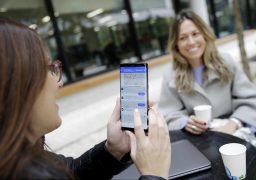Case study: BBVA – salute the speed
BBVA is receiving widespread recognition for its progress and innovation within the digital banking arena.
The banking group’s push to develop functionalities and services for its customers saw it place it the top spot in Forrester Research’s 2017 European Mobile Banking Benchmark. This recognised the intensity and speed at which BBVA has made progress over the past two years in the digital arena, as well as the broad variety of transactional functionalities and marketing and sales initiatives enabled by its initiatives, particularly its mobile app.
At the end of 2017, BBVA had 22.6 million digital customers, an increase of 25% in year-on-year terms. Of these, 17.7 million were mobile users, up 44% from last year. Another interesting figure is that in 2017, 18% of BBVA’s new customers signed up online.
The bank is also actively involved in the digital market as a whole. It announced in March that it is to increase its stake in UK digital bank Atom to around 39%, or some £167 million. It is also an investor in solarisBank, a German banking platform, following its participation in a Series B funding round. In addition to this investment round, BBVA is also acquiring solarisBank’s stake from Unicredit’s German unit.
BBVA’s artificial intelligence (AI) voice assistant MIA, launched within in Turkish bank Garanti, has been a quiet success. Turkey is a highly mature market in terms of digital offerings and as a leading bank in Turkey, Garanti has been sure to invest and develop its digital offering to meet the demands of its mobile-savvy customer base.
So far Garanti has: 6.2 million digital customers, 5.4 million of which are mobile and 95% of non-cash transactions being made through digital channels. The bank is also the “Best Digital Bank in Turkey” and has the “Best Mobile Banking App in Turkey”, according to World Finance. And according to Mediacat Lovemark Research, it is also the “Most loved mobile bank in Turkey”.
Prior to developing its AI voice assistant, Garanti built a robust mobile banking app – CepBank. The app’s popularity lies partly in its user-friendly log-in – it uses eye recognition to verify identity. This works by scanning the structure of the eye and then generating a personalised key that the bank stores.
Then, the bank sought to find out how the app’s functions could be most effectively served by an AI-based voice assistant within its mobile banking app.
And so, MIA – Mobile Interactive Assistant – was born.
“For MIA, we analysed commonly used mobile app functions that we thought would be most valuable for customers. We looks at customers’ need and daily routines to define different use cases. From there, we designed a character to embody the mobile assistant concept and create a companion-like emotional relation with the user,” says Didem Dinçer Başer, executive vice-president, digital banking at Garanti Bank.
MIA basically lets users of the mobile app speak to it to transact. It answers questions about the latest account activity, performs transfers, lets customers buy or sell foreign currency or find out the exchange rate, all via voice. So far, 1.3 million customers have had more than 12 million interactions with MIA.
To do this the bank has employed the latest voice technology like Apple’s Siri or Amazon’s Alexa use – to its mobile banking app. The result is something much more sophisticated and customisable. It uses AI to learn from its conversations and therefore continually improve the range of questions that it can respond to.
“MIA also comes with an extensive grammar and comprehension capability, creating a distinctive experience that is also compelling for the audience,” says Başer.
An example of its intelligence is that it can route customers to alternative branches if they are looking to make an appointment but their own branch has no availability. It also routes customers to ATMs and digital channels if branches are particularly busy.
Omnichannel
One of the most relevant characteristics of MIA is that it provides an omnichannel experience. This means that if users’ requests cannot be addressed on a smartphone, MIA is capable of offering other ways to address them.
Başer comments: “For example, when customers say that they have lost their credit cards, MIA asks: ‘Would you like me to call Alo Garanti right away to cancel your card?’. If customers say ‘yes’, the app puts them in contact with customer service at the call centre without having to log in again or identify themselves.
“Customers really like this sort of thing as it removes the stress and hassle out of everyday banking and provides a more joined up experience for them.”
But Garanti is not the only part of the bank making its mark within the digital world.
Indeed, within its home market in Spain BBVA has made significant strides within its mobile and digital offering. It already has a high quality mobile app which has gone from offering 16% of the bank’s products three years ago, to 92% today.
The app also has three big data-based functionalities: Bconomy (an in-app financial wellbeing tool), BBVA Valora, which allows users to calculate the best price at which to rent, sell or buy a home and Baby Planner, a tool to better understand how having a baby will affect users’ finances. In addition the BBVA Contigo Advisor function, gives users access to a team to manage day-to-day investments and borrowing from their phone.
The firm has just added to its capabilities by allowing users to automate payments via a new app – which is verified using biometric technology. The app facilitates making reservations and placing orders from a smartphone. Currently on trial at BBVA’s headquarters the idea is that users can arrive at a restaurant with a reserved table waiting for them, eat and then leave without having to ask for the bill or manually pay.
This latest functionality adds to the functionalities that the bank can offer and extends its reach out of the day to day banking zone. It means that more and more people will use the bank’s technology for non-banking related purposes and therefore compounds the bank’s usefulness – hopefully adding value and underscoring loyalty.
Chatbot
But it was the introduction of a chatbot and mobile payments functionality, Cashup, over social media platforms and messenger services last year that really underscored the bank’s capabilities.
“Without a doubt 2017 saw the take-off of chatbots. The number of organisations that use chatbots or virtual assistants to communicate has grown exponentially. In fact according to a Gartner study, by 2020 almost 80% of companies will have their own chatbot,” says Raúl Navarrete, mobile channel manager of BBVA Spain.
By Alison Ebbage
This is an excerpt. The full article is available in the April 2018 issue of the Banking Technology magazine.
Click here to read the digital edition – it is free!













































